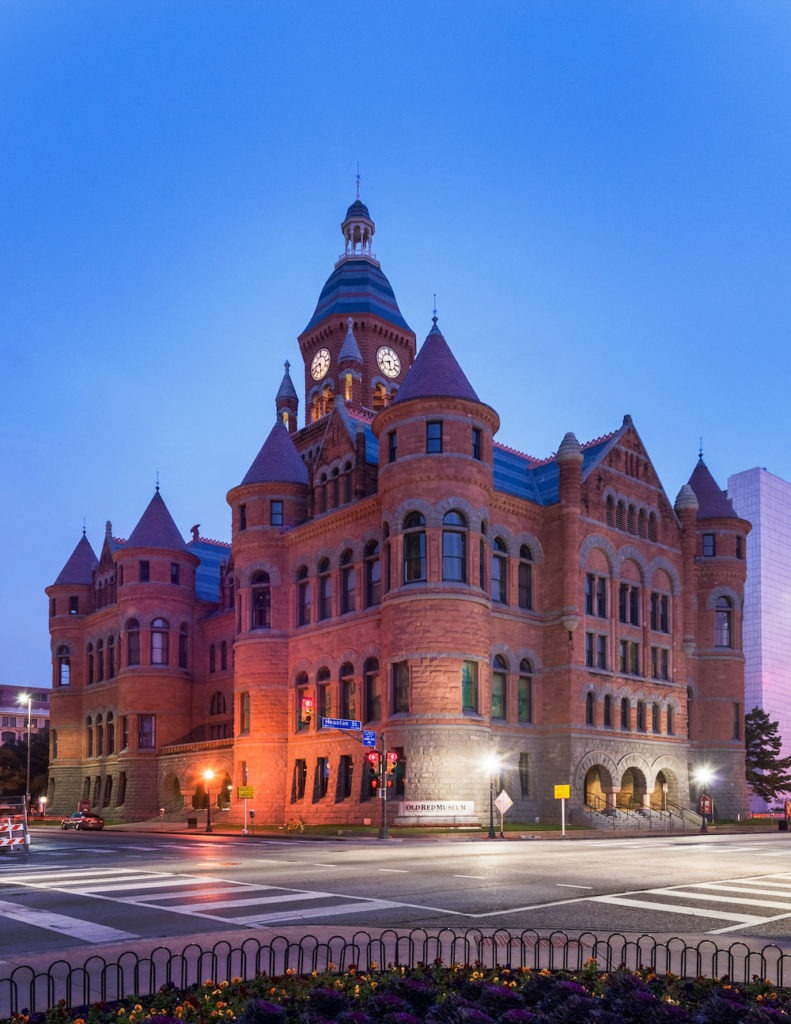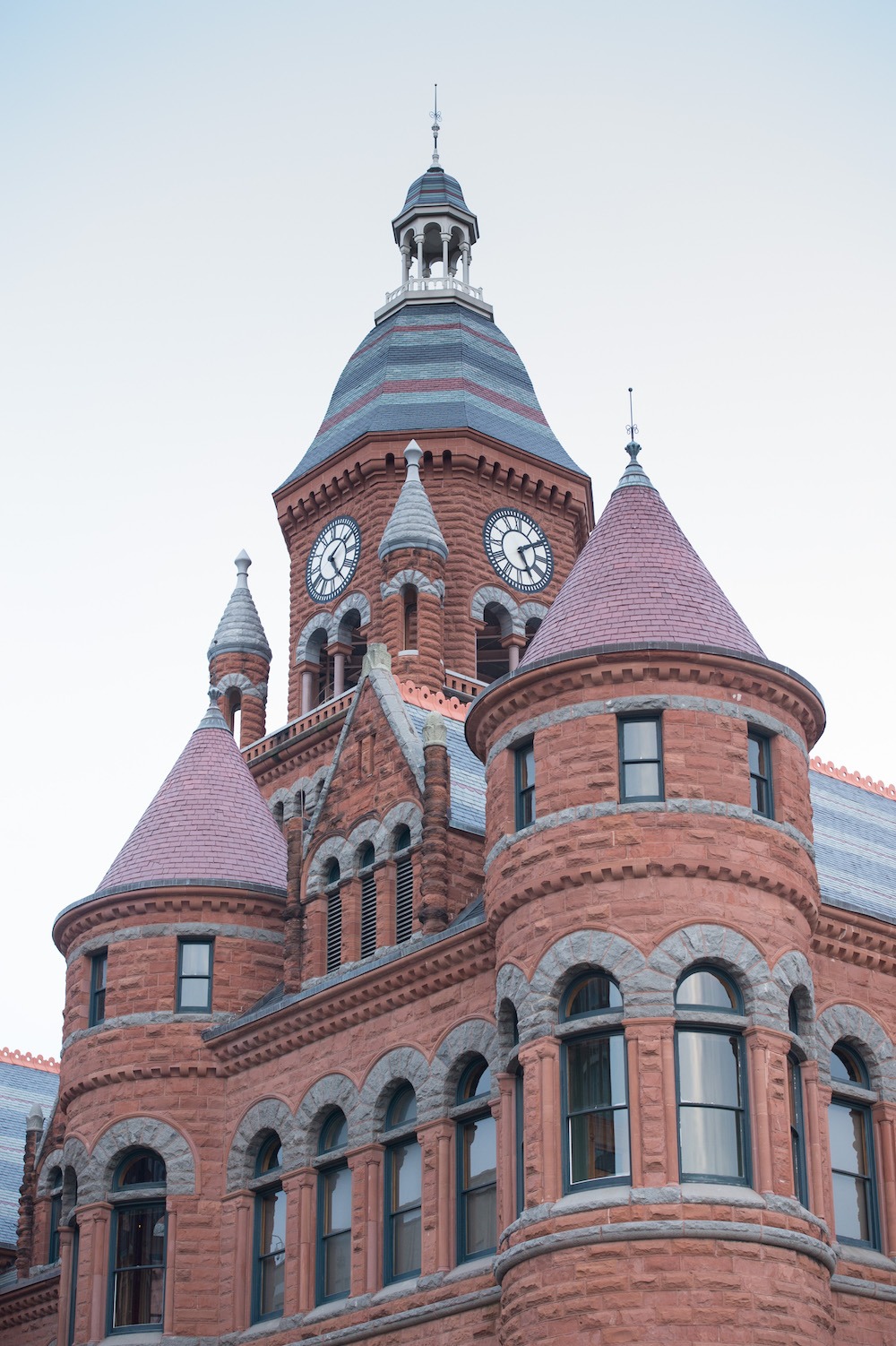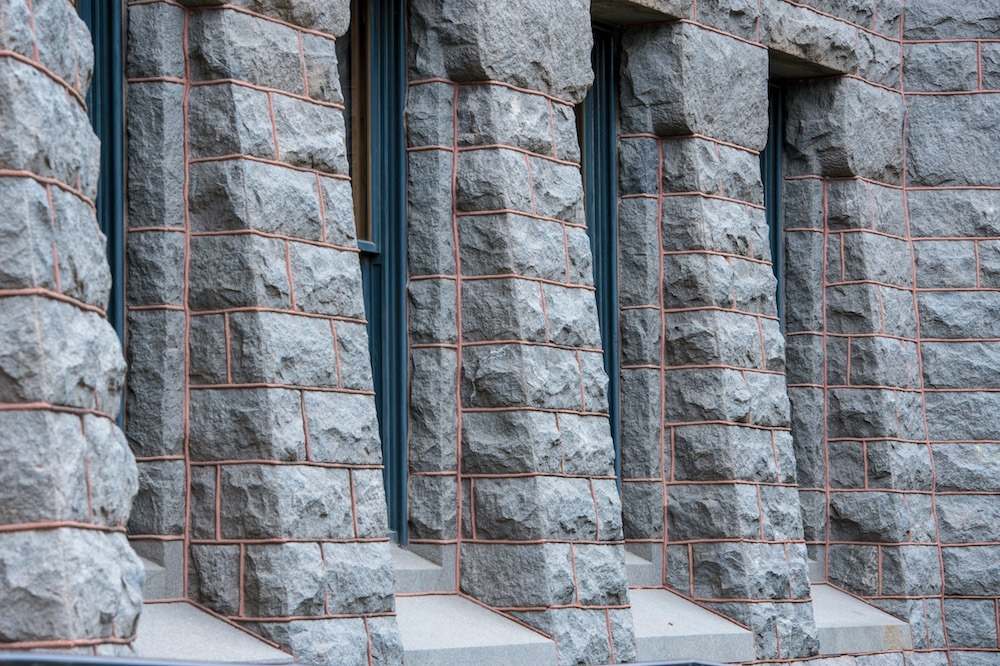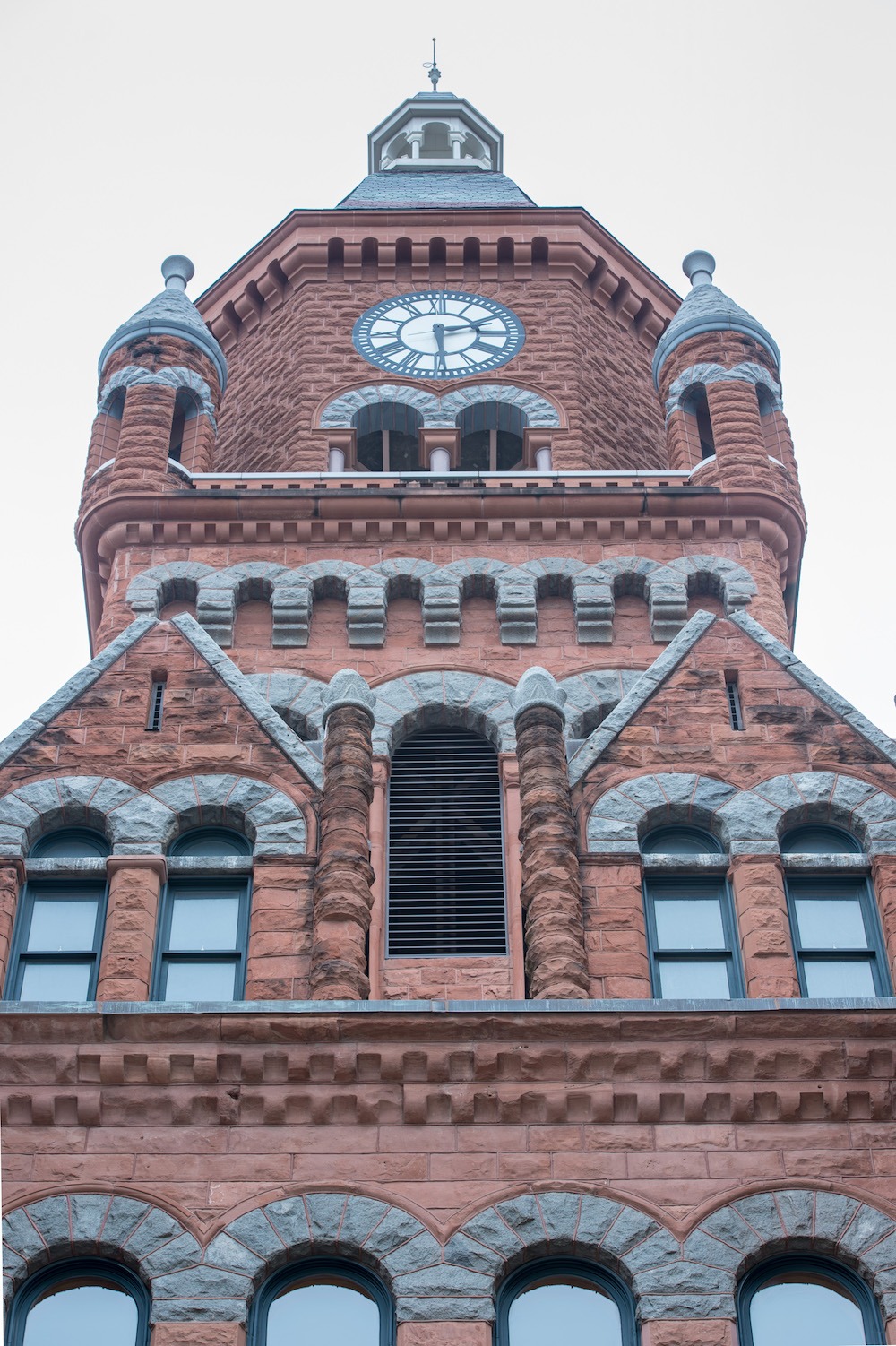The Old Red Museum of Dallas County History and Culture proves Dallas has more historical offerings than the assassination of a president. Though it could rightfully also be called Phoenix or Lazarus because the building at 100 South Houston Street has literally risen from the ashes not just once or even twice but several times.
The massive sienna-bricked building with the eight turrets, the former Dallas County Courthouse exemplifies one type of architecture prominent at the time of its construction in 1890: Richardsonian Romanesque. Its massive restoration came to fruition in 2007, though the building took its proper place on the National Register of Historic Places on December 12, 1976. The museum overlooks the Trinity River. It’s situated within blocks of the John J. Kennedy Memorial Plaza, the Sixth Floor Museum at Dealey Plaza, the Plaza itself, the Dallas Holocaust Museum, and Dallas World Aquarium.
The Big Red Building that Could
The first courthouse, a log building erected just after Dallas became a county in 1846, sat on a piece of land designated as public land two years earlier by the city’s pioneer settler/founder John Neely Bryan. It burnt to the ground. Then Dallas became the county seat in 1850 and Bryan deeded the property to the county, which soon set about building a larger structure. County officials thought they were clever by building the second building, a $7,400 square, two-story structure, out of brick after a fire nearly destroyed the entire city.
They were right; it did survive. They tore it down a few years later, however. The next courthouse, built in stages between 1871 and 1874, bore the Italianate style. When a fire partially burnt that one in 1880 the eminent architect James Flanders remodeled it, only to watch it go down in flames a year later, according to the TexasEscapes.com.
Finally, fed up with ruinous fires, the county spent $100,000 (or $2.3 million today) in its search for a fireproof building, something that could withstand even the most determined flames. Flanders’ response, Second Empire design, incorporated the bones from the previous courthouse and limestone quarried from White Rock Creek. This time his building at least lasted a decade before burning to the ground in 1890.
After this many fires could the city even bear another tear, or had denizens gotten to the point of choosing laughter over tears? Surely there was something commendable about their determination.
This history of the little courthouse that would is part of what gives Old Red its iconic status in Dallas. Its current manifestation is the sixth consecutive courthouse to occupy this site. Considering the previous five courthouses located on that site had burnt to smithereens, Dallas county commissioners wanted something strong and formidable. The council had high expectations for this city on the edge of the frontier. Council members approved a quarter of a million dollars for the building in 1890 and saw it finished two years later. That was good timing, considering the economy took a dive in the Panic of 1893, the beginning of a four-year depression caused by the overbuilding of railroads and their shoddy financing.
Don’t Mess with the Architecture
Arkansas architect M. A. Orlopp had designed the building in the then-popular Richardsonian Romanesque style, which resurrected certain European elements of the 11th and 12th centuries. The building was constructed of steel and stone, materials more able to withstand fire and similar to those Chicago used when rebuilding after its Great Fire of 1871. It contained columns of local granite and turrets stretching almost 120 feet into the Texas skies. Its original interior program was to have included six courtrooms, two libraries, twenty-nine county offices, ten restrooms, and two passenger elevators.
Orlopp and Robert L. James, the general contractor, got along as famously as builders and architects today. That is to say, the latter was ignoring some of Orlopp’s design.
“The issue created permanent discord, resulting in the removal of James’ name from the cornerstone soon after the courthouse was completed in 1892,” according to TexasLakesTrail.com.
Typical of its highly textural architectural style, Old Red bears a complicated composition that today looks like a geometrical extravaganza. Its massing, however, because of its symmetry, calms the visual smorgasbord. Locally quarried materials such as the Pecos red sandstone bricks and blocks give the exterior its hue, hence its moniker of Old Red. Its blue-grey masonry voussoirs— wedge-shaped stones— form a brow over large round arches separated by short columns, heavy masonry walls built of rough-faced squared stone. Gabled rooflines accentuate towers topped with conical roofs.
Flanders’ original design didn’t stay intact for long. White terrazzo covered original stone steps, plain wood doors replaced ornately carved ones, and the four-story grand iron staircase was ripped out to make room for offices in the thriving 1920s. Throughout the 20th century, periodic additions such as air conditioners and the removal of most of the 100 vivid stained-glass windows, attempts to modernize the building, further besmirched the building’s aesthetics. Trying to convert it into a modern office place without a dedicated effort was tantamount to putting a Model T on blocks and inserting a horn that plays “La Cucaracha.”
Four decades later the city built a new courthouse, the Dallas County Criminal Courts and Records Building, elsewhere, refashioning the would-be great edifice as the State Department of Public Welfare.
A New Appreciation
A century after the building’s erection, with help from the Texas Historic Courthouse Preservation Program, Dallas’s city council kicked off a $23 million restoration project. Dallas architect James Pratt, who fitted the building to include offices in the 1980s, naturally had no plans or BIM models to guide him. He supposedly did find evidence that the building— as Flanders had designed it— was never actually completed.
Pratt relied on early photographs and paid careful attention to what crews revealed in the process of removing aged layers that had added up over time. He replaced breathtaking arches and chandeliers, granite wainscoting, and pastel hues indicative of the Victorian style popular at the time of Old Red’s birthday. He restored the numerous stained glass windows with some original, some refabricated. Same goes for the ornately designed, grand staircase, which crews restored using original and newly constructed elements and embedding a Lone Star inside each step’s tread.
Award-Winning Masonry
Dee Brown Inc. served as the mason contractor for the restoration of the 90-some-foot-tall clock tower that reached en toto up to 205 above the ground. The original granite and sandstone tower featured illuminated glass dials that spread nine feet in diameter on each of its four sides.
The tower often swayed on windy days. Developing structural issues raised concerns that the building couldn’t support the tower’s weight and that it would collapse in on itself. It was therefore removed in 1919. The hole left behind was never turned into anything else and has merely been covered with wood that eventually rotted wood, leaving in its wake pools that played perfect host to the local pigeon population.
During this massive restoration, however, the city prioritized the tower. Brown’s crews rebuilt the tower to its nine-story glory. They included a 4,500-pound bell that the clock would strike, true to the period Old Red was originally built. The clock itself, which makes quite an attraction for avid fans of timekeeping devices, runs automatically, a concession to contemporary times.
“The bell and the clock works that we have in the bell tower today are reproductions and they’re as accurate as we could get them to original specifications,” said Kerry Adams, the museum’s curator and exhibits director on the Dallas Morning News. “We found a 19th-century Howard gravity-fed clockworks that was restored and was electrified so that we don’t have to go up every day and wind the clock.”
Brown’s crews also restored two dragon-like sculptures, a type of gargoyle also known as a wyvern, to match the two that decorated the base of the tower. The project required 3,700 pieces and some 5,500 cubic feet of sandstone and granite and earned the contractor multiple awards. (Read the Masonry Magazine articleon its reconstruction.)
What’s Inside: The First Floor
Today, the first floor houses the Old Red Museum of Dallas County History and Culture’s special exhibits. These exhibits change throughout the year. Visitors can tour the building daily, learn more about the original construction and restoration, and stop at the museum shop.
Dallasites hold a sentimental fondness for one particular item on display on this floor: The Pegasus. The red neon flying horse was originally built for and displayed at the 1939 World’s Fair in New York City. It perched atop a Mobil gas station at the Casa Linda shopping center— itself a veritable landmark and historic attraction— for half a century, appropriately enough as a pegasus is also that petrol company’s logo.
Recent demolition of the shopping center and gas station unearthed the icon. The folks behind the Old Red Museum salvaged Pegasus, and he now greets visitors from a showcase spot in the middle of the first floor.
Another fantastic find was a vault. The vault, built into the building, was unearthed from behind a bookshelf during the restoration process. Workers labored inch by inch to reveal bright colors and intricate designs of the resplendent original façade of the vault’s original heavy steel door. The Dallas County treasurer originally kept land deeds and other records inside it.
The Museum Experience
To create a captivating museum experience, the county brought in Thomas H. Smith, an avid supporter of Dallas history since 1980. He was renown for his work on such projects as the Legends of the Game museum at the Texas Rangers baseball stadium, which is located between Dallas and Ft. Worth. Helping him were historians representing the following groups:
- the Dallas Historical Society,
- city of Dallas Municipal Archives,
- Dallas Public Library, and
- the Texas State Historical Association,
Together the group made sure the museum acknowledged the county as home to people who hail from 67 countries and to 30 other cities. Therefore the history celebrated at the museum goes beyond the city of Dallas to include the county’s cultural, economic, political, and social history.
On view are hundreds of artifacts. They range from horrendous to honorable and tragic to comic. The museum further celebrates local events in theatre and opera, war weapons and sports paraphernalia. The museum features some beloved items from popular culture too, such as the Stetson worn by J.R. Ewing in the popular 1980s (and recently remade) show about a wealthy oil family Dallas. Some of the most mesmerizing relics include black and white photos of various manifestations of the courthouse, from 1855, 1872, and 1881.
Through video, audio, and touchscreen methods visitors enjoy a glimpse of life at a time when the city hosted a dinner for 7,000 people as it welcomed its first train in 1872 or later when Mexicans collected at what became known as “Little Mexico” as they fled the Mexican Revolution of 1910. They also see John F. Kennedy’s assassination as captured on video from one of the court house’s very balconies and film footage from the Bonnie and Clyde ambush.
In four galleries, also known as theatres, show how settlers came to, settled on and fought to survive there on the frontier; tell about the state’s contributions to the Confederacy during the Civil War and the display instruments used by local slaves back then; demonstrate the effects of ever-modernizing transportation changed the area; explain how oil turned Dallas into an economic powerhouse; and showcase contributions such as Texas Instruments, local blues and other musical icons such as Erykah Badu, Norah Jones, and Mary Kay Cosmetics. For example,
- The Early Years gallery discusses the county from prehistory to 1873. In it exhibited items include shark teeth and Dallas founder John Neely Bryan’s original plat of the city.
- The Trading Center gallery edifies visitors about the county’s growth and development from 1874 to 1917. It includes information about the formation of nearby cities such as Richardson, Irving, and Lancaster, which were important trading centers for farmers. Visitors can also see one of the county’s first water utilities, a wooden water pipe.
- The Big D gallery contains historical info from 1918 to 1945. Dallas became known as the Big D during this period between world wars. It contains such darling artifacts as the county’s first traffic light and souvenirs from when Texas celebrated it centennial.
- Finally there’s the World Crossroads gallery that takes us from 1946 up to 2007. Here visitors witness cool historical artifacts such as posters and films from Harlemwood, the city’s prominent African-American filmmaking center. They can also discover how the Dallas-Fort Worth area became home to nearly two dozen Fortune 100 companies. That includes Exxon Mobile, of course, in addition to AT&T, American and Southwest airlines, JCPenney, Dean Foods, Alliance Data Holdings, Dr Pepper/Snapple, Michaels, and D.R. Horton, among others.
In honor of the museum restoration’s tenth anniversary, a special exhibit titled “50 Objects, 50 Stories” runs through June 8. It shows how items and exhibits of the museum came to be. It will be followed from July 1 into June 2019 by an exhibit called “American Childhood: Celebrating Classic Toys.” On display then will be 100s of America’s most adored toys developed from the 1880s to the 1980s with tales of how the economic and social zeitgeist influenced their origin. Of course there will be a dollhouse, a model train set, and board games every family knows. There will also be Lincoln Logs, Barbie, and Fisher-Price.
Speaking of Kids
In the Children’s Learning Center, kids enjoy a host of interactive games. They can try on vintage clothing, discover old-fashioned games, and explore Dallas’s old days and culture through various other interactive activities in analogue and digital form.
Janene Pearson, a teacher who brought a class through the museum for a special educational opportunity, says the field trip went wonderfully. “One little boy turned around and said, ‘Yes! I never knew history could be so much fun’,” she said.
Also on the second floor are two-story rooms that used to serve as courthouses. Today these spaces host exhibitions where tourists witness the building, the city, and the county from its very beginnings through contemporary times. The rooms are adorned in a cornucopia of colors and brass fixtures. The exhibitions within go beyond the building’s history, edifying onlookers about the city’s and the county’s history too.
The building has come live in other ways too. Office workers go to and fro among the third-floor offices. The fourth floor plays host to a variety of public events such as weddings and other spaces available for rent. It is there visitors can find the Hatton W. Sumners Restored Courtroom, which “stands as a testament to the craftsmanship and detail of the 1892 courthouse,” according to OldRed.org.” Fully restored, it contains an elaborate judge’s bench, jury box and gallery seating.”
The Future Is Education
Of the estimated 75,000 people who enter the museum doors each year for weddings, social events, and tourists, it’s only about 20,000 who are paid visitors, the Dallas Newsreported in 2015. Grade-school children comprise half that figure. Conversely, the nearby Perot Museum of Nature and Science ostensibly sees more than 1 million visitors, and the Sixth Floor Museum is said to draw more than 400,000 people annually.
Low visitor figures means a weak operating budget for the county asset and an inability to repay rent— let alone much of its restoration costs. The Dallas Newsreport claims that county taxpayers have been saddled with the tab, including the installation of a new $1.6 million roof.
Learn more about the Old Red Museum of Dallas County History and Culture at www.oldred.org.






